
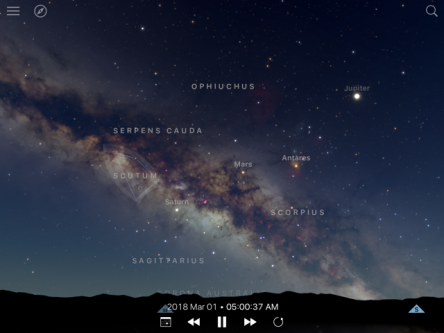 • March 1 – Around 5:00 A.M., CST, go outside and face west to find the almost full moon. Now, face south and look for the brightest thing in this part of the sky, this would be the planet Jupiter in the constellation of Libra. Looking back towards the southeast you should see the red planet Mars in Scorpius (adjacent to the red supergiant star Antares: whose name means “rival of Mars”) as well as Saturn within the constellation Sagittarius. It’s a lovely grouping of solar system bodies with the moon leading the way in the sky.
• March 1 – Around 5:00 A.M., CST, go outside and face west to find the almost full moon. Now, face south and look for the brightest thing in this part of the sky, this would be the planet Jupiter in the constellation of Libra. Looking back towards the southeast you should see the red planet Mars in Scorpius (adjacent to the red supergiant star Antares: whose name means “rival of Mars”) as well as Saturn within the constellation Sagittarius. It’s a lovely grouping of solar system bodies with the moon leading the way in the sky.
Full moon occurs at 6:51 P.M., CST
On this day in 1882, the Russian probe Venera 13 sends back the first color images of the surface of Venus.
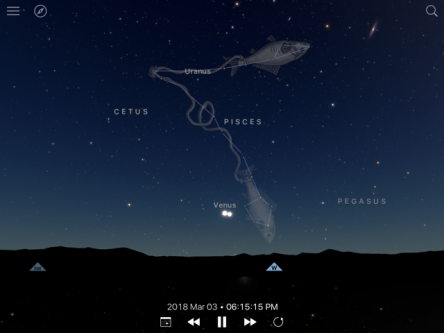
• March 3 – A special observing challenge: see if you can spot the two innermost planets, Venus and Mercury, separated by just one degree in the early evening sky, very low along the western horizon. The two planets will drift apart over the next few evenings but will still remain very close together up until about mid-month. Binoculars or a small telescope will help you split the two apart if you observe them from around the 3rd to the 5th.
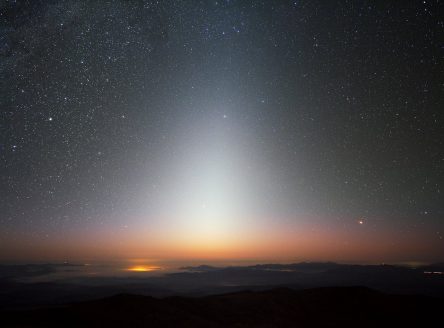
• March 5 – The Zodiacal Light may be visible for the next two weeks. In late winter and early spring, it is seen for a couple of weeks in the western sky just after sunset, but in late summer, early fall, it is seen in the dawn sky and is sometimes called the “false dawn”. From a dark sky location, away from city lights, it will appear as a strange glowing light in the shape of a cone, or pyramid. The light is the result of the Sun’s light, reflecting off the dust grains that float around in between the planets. These dust grains are the leftover material that went into the making of our solar system. Look along the western horizon about an hour after sunset. Avoid evenings when the moon is bright.
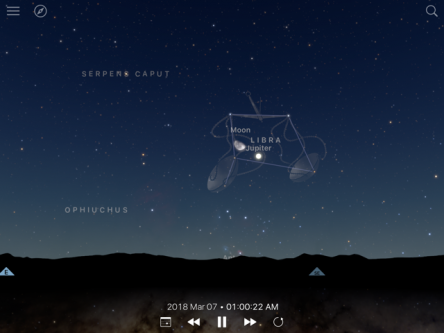
• March 7 – The waning gibbous moon and Jupiter are only a few degrees apart on the sky. Begin looking towards the southeast at around 1:00 A.M. or 2:00 A.M., CST.
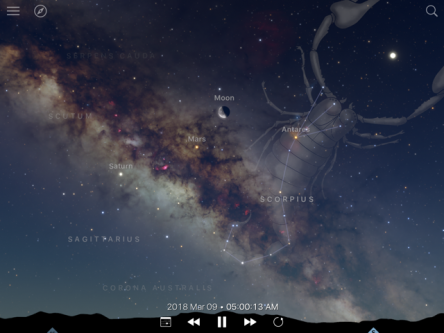
• March 9 – The moon and Mars are just a few degrees apart in the morning sky.
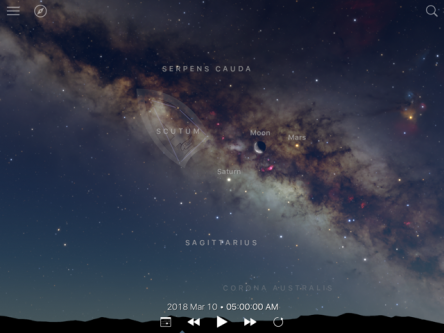 • March 10 – The moon and Saturn are just a couple of degrees apart in the morning sky.
• March 10 – The moon and Saturn are just a couple of degrees apart in the morning sky.
STAR PARTY! The Central Arkansas Astronomical Society will host its first free public star party of 2018 at Woolly Hollow State Park, 82 Woolly Hollow Road, Greenbrier, AR, from 7:00 P.M. to 10:00 P.M. CDT. Star parties are where astronomers set up their telescopes and then invite members of the public to come out and look through them. This is a great opportunity for you to see many of the amazing celestial sights overhead as well as to learn more about telescopes, and the night sky.
• March 11 – Daylight Saving Time Begins at 2:00 A.M.
The moon is at apogee, its most distant point in its orbit for the month, 251,455 miles, at 4:14 A.M. CDT
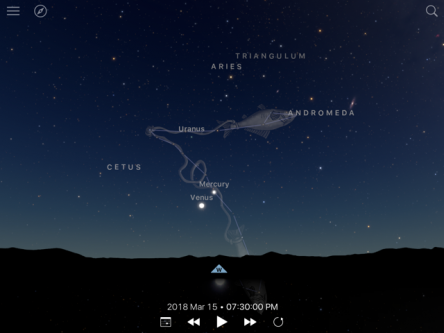 • March 15 – The planet Mercury is at its greatest eastern elongation, 18 degrees from the Sun, at 10:00 A.M. CDT. When an inner planet is visible after sunset, we say it is in its eastern elongation. If it is visible in the morning sky, we say that it is in its western elongation. Its greatest elongation refers to the fact that the planet is at its greatest angular separation from the Sun. This evening will be a great time to spot the elusive innermost planet. Go out about a half hour after sunset and look for it low upon the western horizon. A small telescope will show you a disc that is a little more than half-lit.
• March 15 – The planet Mercury is at its greatest eastern elongation, 18 degrees from the Sun, at 10:00 A.M. CDT. When an inner planet is visible after sunset, we say it is in its eastern elongation. If it is visible in the morning sky, we say that it is in its western elongation. Its greatest elongation refers to the fact that the planet is at its greatest angular separation from the Sun. This evening will be a great time to spot the elusive innermost planet. Go out about a half hour after sunset and look for it low upon the western horizon. A small telescope will show you a disc that is a little more than half-lit.

• March 16 – Caroline Herschel was born this day in 1750. Caroline is the sister of famed British astronomer Sir William Herschel and for too long has been simply known as his assistant. But Caroline was an adept astronomer in her own right and made numerous important contributions to the field by discovering and cataloging comets, galaxies, and nebulae. King George III recognized her abilities by paying her a salary as an assistant to William, who was serving as Court Astronomer, and thereby making her the first woman officially recognized in a scientific position. She would later be given an honorary membership into the prestigious Royal Society, becoming the first woman to be so honored. Among her other “firsts”, Caroline was also the first woman to discover a comet.
• March 17 – New moon occurs at 8:12 A.M., CDT.
Look for Mercury and Venus about 4 degrees apart, low in the western sky, at around a half hour after sunset.
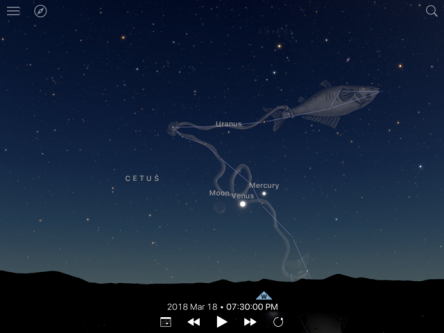
• March 18 – Look for a slender crescent moon (only 4% illuminated) just a few degrees to the east of Venus and Mercury right after sunset.
• March 20 – Vernal equinox, first day of spring, begins in the northern hemisphere at 11:15 A.M. CDT. On the March equinox, the Sun appears to cross the celestial equator from our viewpoint here on Earth. On this day, the Sun rises due east and sets due west. On the equinoxes, the Earth is in a place within its orbit around the Sun to where the length of the day and the night are close, but not quite equal. From Little Rock, sunrise occurs at 6:44 A.M. and sunset is at 6:00 A.M.
• March 24 – First quarter moon occurs at 10:35 A.M. CDT.
• March 26 – Moon is at perigee, its closest point in its orbit for the month, 229,352 miles, at 10:35 A.M. CDT.
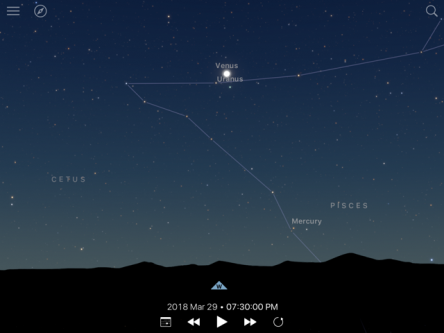 • March 29 The planet Venus and Uranus are only 4 degrees apart in the early evening sky. Uranus is only at 6th magnitude, right at the cut off point for naked eye visibility so you will need powerful binoculars or a small telescope to see it. Your best bet for viewing Uranus will actually be in the early part of the month when it is higher upon the sky. Use an app or a sky map obtained from online or an astronomy magazine to find it.
• March 29 The planet Venus and Uranus are only 4 degrees apart in the early evening sky. Uranus is only at 6th magnitude, right at the cut off point for naked eye visibility so you will need powerful binoculars or a small telescope to see it. Your best bet for viewing Uranus will actually be in the early part of the month when it is higher upon the sky. Use an app or a sky map obtained from online or an astronomy magazine to find it.
• March 31 – Full moon officially occurs at 7:37 A.M CDT. Look for it to rise right after sunset in the eastern sky.